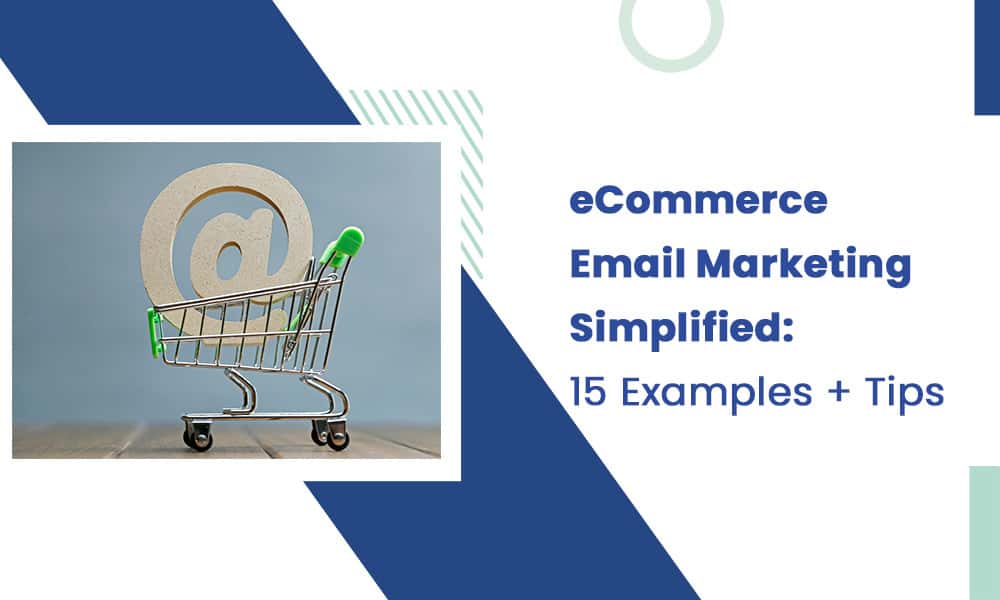Think of the last time you opened a promotional email.
Was it the quirky subject line that got you clicking? Or, it could have been an offer you couldn’t turn down for one of your favorite brands! Or, maybe you just had time to kill and wanted to see something new.
And, all of us have abandoned a cart at some point (don’t lie!), only to have eCommerce stores come at us in our inbox like David from Schitt’s Creek.

The key is to level up your email marketing game so that people don’t find your emails spammy and actually want to view them.
In a world where 99% of consumers check their personal email daily, eCommerce companies cannot afford to miss out on this huge swathe of prospects.
So, in this article we will break down for you:
- The benefits of eCommerce email marketing
- Types of email campaigns
- Types of emails that eCommerce companies need to master + real-life examples
- Expert tips for eCommerce email marketing
Let’s get right into it then!
Table of Contents
eCommerce Email Marketing Drilldown
I recently watched my friend unsubscribe to all the promotional emails in his inbox … The horror!
Even though street-smart wisdom would tell you that people generally hate marketing emails, surveys have found that email marketing generates an ROI of $42 for each $1 spent! Let’s break down why email is so important for eCommerce.
Why is email marketing important for eCommerce success?
Here are just some of the reasons email marketing is an indispensable part of your eCommerce success.
- Email marketing builds long-term credibility for your eCommerce firm. When prospects get regular emails from your brand, it also builds a sense of familiarity with your brand.
- Email marketing drives eCommerce sales. In fact, research has shown that 61% of consumers would like a weekly promotional email.
- You can save a lot of time by automating certain email campaigns. With good email marketing software, you can personalize emails to drive more engagement.
- Email marketing is one of the best ways you can add value to your customers’ lives. By emailing helpful content, tips, and guides, you can establish rapport and credibility with your prospects.
- You can build a stable email list, and a good CRM system can help you with lead scoring so that you continue to build this list as your company grows.
Read also: B2B Email Marketing Examples From Billion Dollar Companies
What are the common types of emails for eCommerce?
There are three major types of emails that your eCommerce store will need to master.
1. Promotional emails
As the name implies, these emails are used by eCommerce stores to promote their products, offer discounts, and announce new products or product categories. These would include all those black Friday deal emails, limited-time discounts, seasonal promotions, and new product launches.
2. Transactional emails
These emails are sent out to inform customers about the status of their transactions at your eCommerce store. This includes order confirmation, shipping confirmation, and sending invoices for their purchases.
3. Lifecycle emails
Lifecycle emails are sent regularly to prospects, based on their stage in the customer lifecycle. Imagine if you get a referral request email from a brand you don’t even know! To avoid a faux pas like this, customers are segmented based on various factors including their recent interactions with your eCommerce storefront.
Read also: ECommerce Email A/B Testing Basics For Beginners
Types of Emails You’ll Need to Master (and Send)
Here are the 15 most important categories of emails every eCommerce business has to master. There is a real-life example for each, along with best practices for creating and sending out each type of email.
1. New product or category announcement
Subject Line: “Snack Drop Alert! New year, new nuts!”

A new product launch or category launch is one of the most important emails eCommerce stores have to master. The goal of this category of emails is to get prospects interested in your new product, and eventually buy them.
In the email example above, notice the clear call to action (CTA) buttons.
Here are some expert tips for your new product launch emails:
- Create a catchy subject line for the email in under 40 words.
- Use strategies like building anticipation, giving previous customers an exclusive preview, or even free samples for those interested.
- Include links where prospects can get more information about the new product. This can include blog posts and links to videos.
- Ensure that you use high-resolution, clear images for the new product.
- Include multiple CTA buttons, so that prospects know where to take the next step if they are interested.
Read also: eCommerce Transactional Email Optimization: What to Do & Not to Do
2. Time-sensitive deals
Subject line: Enjoy 40% off on our Twice Upon A Year Sale!

These are emails you can send out to inform prospects about limited-time discounts or deals. The main strategy is to create a sense of urgency, without going overboard. The Shop Disney email above clearly specifies the dates for the discount with free shipping.
Here are some expert tips on sending limited-time deals for your eCommerce firm:
- Use your segmented prospect list to target people who are most likely to be interested in the products.
- Ensure that you personalize your email to boost the open rate for the email.
- Clearly lay out how and how much they can save if they use this limited-time deal.
- Include just one or two CTA buttons, so that prospects can be taken to the product page immediately.
Read also: 15 Easy Steps to Build a Personalized eCommerce Marketing Plan
3. Subscriber-only discounts
Subject Line: Your exclusive discount on a lifetime of Calm!
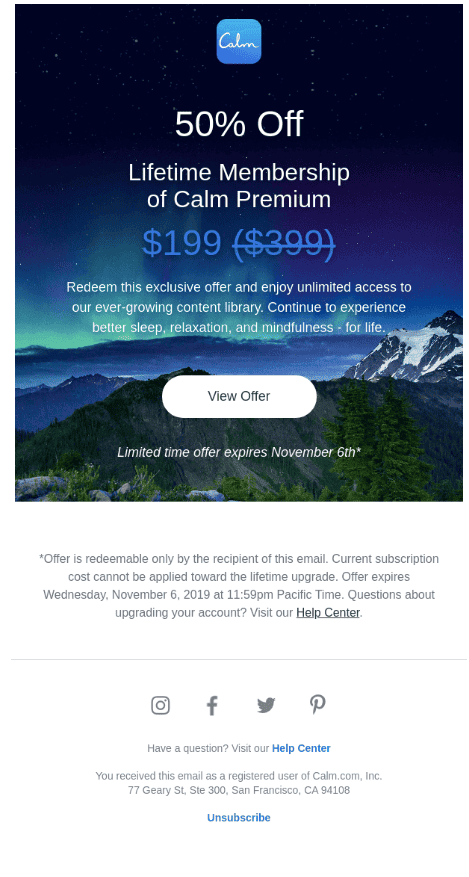
For any eCommerce business, your subscribers and repeat customers are inextricable from your success story.
So, a good way to make them feel special and appreciated is to offer exclusive discounts that are only available to them. A study by RetailMeNot using Google Consumer Surveys found that 89% of consumers said that an online deal had triggered a purchase!
In the example above, there’s a 50% discount for people who are already subscribers of the Calm app.
Some expert tips for crafting a high-converting subscriber-only discount email are:
- Create a sense of urgency with a limited-time deal. The exclusivity of the deal too would be enticing for some customers.
- Clearly specify the value of the product, and how this deal will help consumers save more.
- Include a single, clearly-defined CTA button. And an advanced tip is to specify the value provided by the deal in the CTA button. For example, instead of saying ‘View Offer’, you can say ‘Get $199 Off Today’.
- Thank the subscribers for having been a part of your success story. This will make them feel valued.
Read also: 5 Awesome Promotional Email Examples From Top Brands
4. Seasonal promotions
Subject Line: The Blow-up Sale: Make a splash this summer with your new Casper pool mattress
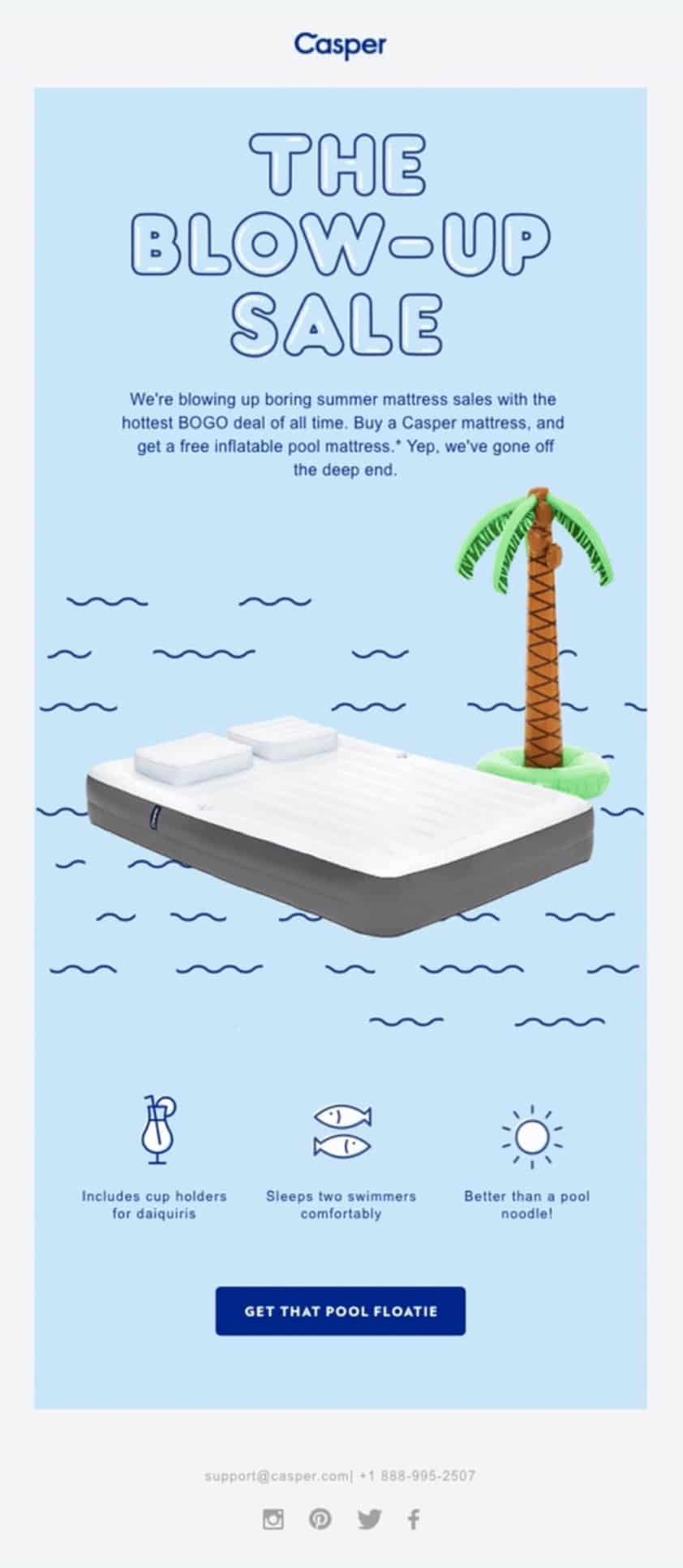
The holiday season is one of the times when email marketers can really shine with their creativity. Of course, this isn’t just limited to the holiday season at the end of the year. These campaigns can include summer and spring seasonal promotions too.
Keep these factors in mind while creating your seasonal promotional email campaigns:
- Keep the tone light and festive. Your prospects are likely to be in a relaxed mood, so capitalize on the festive cheer in the air.
- Stick to a single holiday theme. Your seasonal campaign has to tie in with your brand. So, it’s advisable to find a holiday theme that works for your eCommerce store and stick to it.
- Include only one CTA button with the intention of driving purchase. Get creative with it, like the example above.
- Offer a limited-time seasonal discount with the mail wherever applicable.
- For seasonal emails, timing is everything! So, plan your strategy well in advance so that your email reaches customers at the right time.
- Segment your email list, and target the prospects with higher lead scores.
- Setting up a drip email campaign for your seasonal promotions is a great idea. This way, you can gradually warm up prospects and build a sense of urgency as the holidays draw nearer.
👉Discover the most effective opt-in email strategies that will transform your subscriber list in our detailed article! 📈
Read also: eCommerce Email Marketing UTM Parameters and How to Use Them
5. Check-in email
Subject Line: Happy Holidays, {customer name}!

As any eCommerce marketer worth their salt would tell you, your relationship with customers doesn’t end after they make a purchase. And, check-in emails are a great way to keep your repeat customers engaged and feel valued.
Ideally, these emails should be personalized to include the customer’s name in the subject line or the body of the email.
Here are points to consider while sending out check-in emails to build rapport with customers:
- Personalize each email to include the customer’s name. Marketers can typically expect to see a 26% increase in open rates with personalized emails. One goal of the check-in email is to make the customer feel valued, and you can’t do this without email personalization.
- You can include a call to action (CTA) button for products that they may be interested in. But, remember that this is not the main goal of your check-in email.
- Write excellent content for your email. Make sure that the tone is light, friendly, and warm.
- Make sure to thank your customers for being a part of your success story, and reassure them of your commitment to providing the best value and service for them.
- You can set up automated check-in emails for client milestones like birthdays, and anniversaries. It doesn’t have to be limited to the holiday season at the end of the year.
Read also: A Brief eCommerce Email Marketing Strategy Guide
6. Shipping confirmation email
Subject Line: {Customer name}, your order has been confirmed and packed!

This is an example of transactional emails for eCommerce stores. Once any customer makes a purchase from your eCommerce store, you will have to send them a series of post-purchase emails. This can include anything from sending their invoice, to asking for reviews of the purchased products.
Some expert tips for your shipping confirmation emails are:
- Thank the customer for their purchase.
- The CTA is entirely optional for these emails. You can send a simple shipping confirmation like the example above. Or, you can try to cross-sell products. For instance, if someone has purchased a shampoo from your eCommerce store, you can cross sell products like conditioners, leave-in serums, or hair mousse.
- Give clear details about the status of their order and an order summary. List all the items that have been shipped, along with the net and gross amount paid.
- Ensure that you give them the shipment number or a link to track their order, as applicable. You can also include the estimated date of delivery with this email.
Read also: From Lost Sale to Sure Sale: Mastering the eCommerce Abandoned Cart Email
7. Order confirmation and email receipts
Subject Line: {Customer Name}, your order #123 from White Ink Papeterie is confirmed!
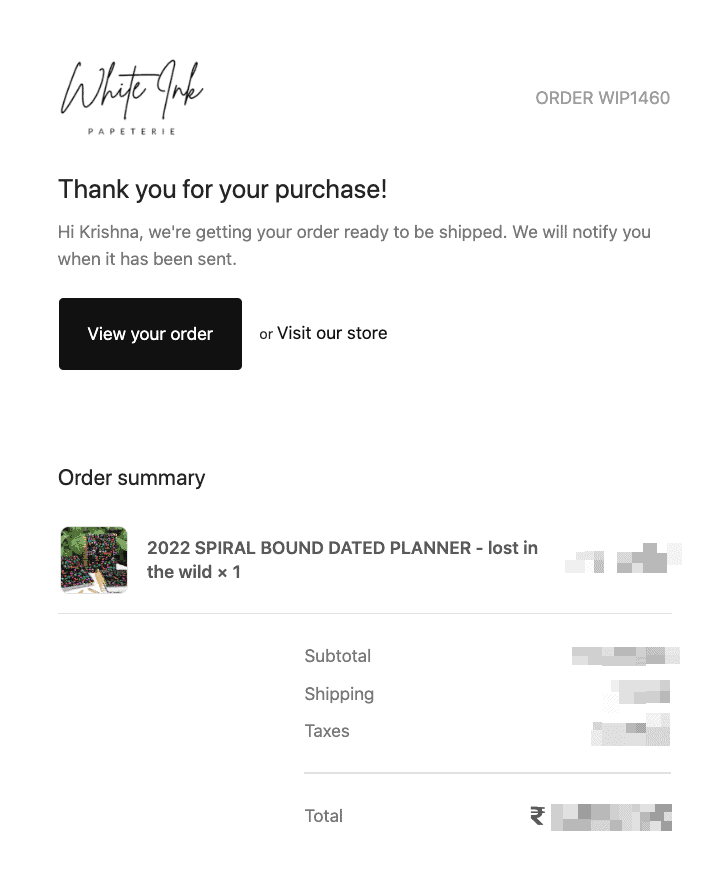
This is yet another example of a post-purchase transactional email for eCommerce stores. Here, the goal is to inform the customer about the status of their order. Usually, an invoice is attached with the confirmation email as well.
Here are some tips to keep in mind:
- Don’t include very loud graphics or do too much with this email. Remember, your goal is to give customers the maximum information rather than convert them.
- Include the customer’s name in both the subject line and the body of the letter. You can also give details of the shipping address, where the product will be delivered.
- Include one or two call-to-action (CTA) buttons.
- Give an order summary, where the customers can see the products they have purchased, along with the price break-up.
- You can set up an automated workflow for these emails. So, whenever customers make a purchase, the email is automatically sent to them. This will save you time and effort, especially when you have a large number of purchases at the same time.
Read also: Crafting the Perfect Mobile-Friendly eCommerce Email Design: [Tips + Examples]
8. Cross-sell email
Subject Line: Confirming your executive razors!
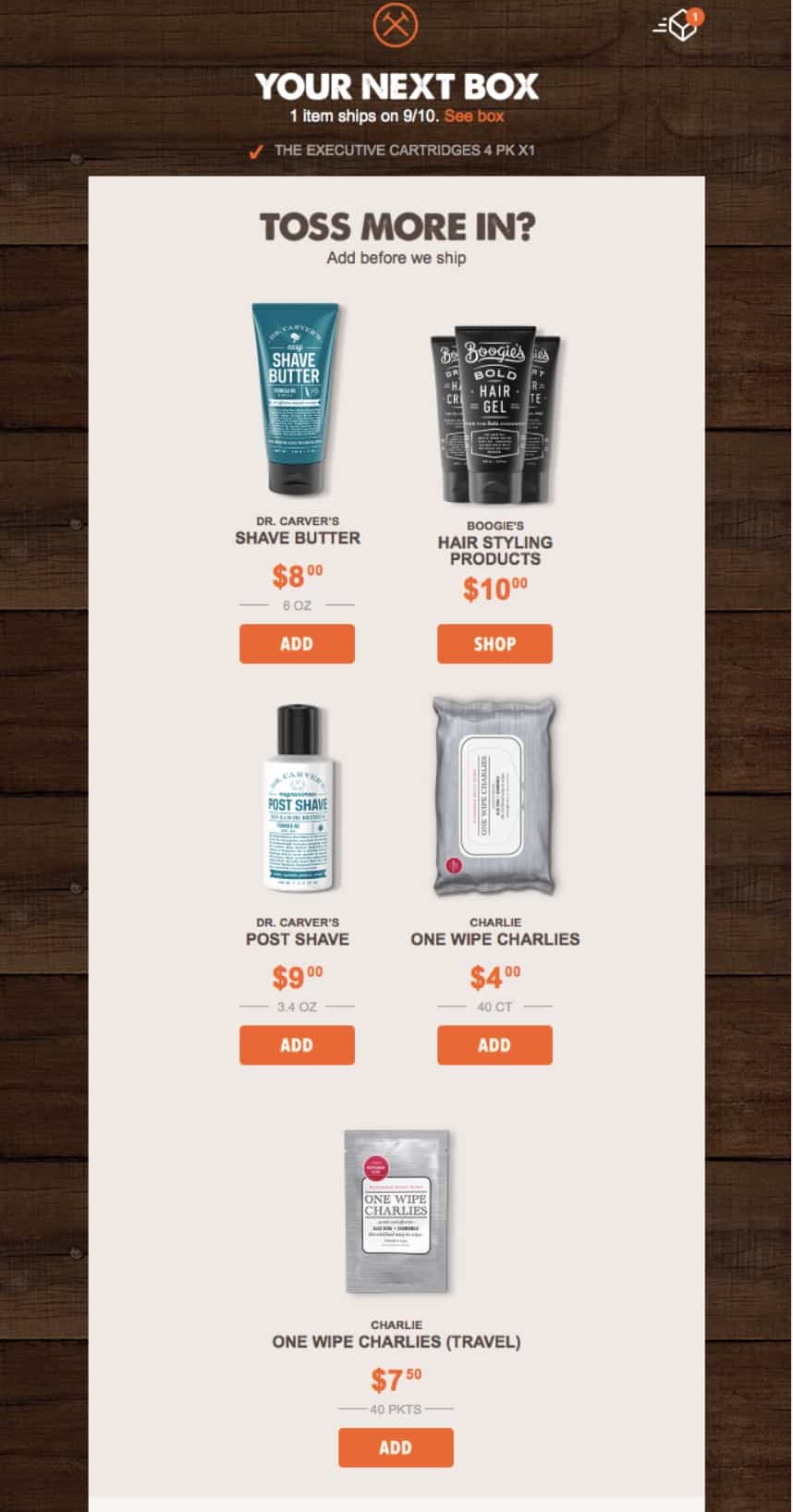
Cross-selling simply means getting your web customers to buy complementary products after they’ve already made a purchase or added to cart.
In this example, after a customer has purchased executive razors, they may also consider buying other related products like shaving cream, post-shave colognes, or face wipes. You can automate this process using a good marketing automation platform.
Here are some important tips to keep in mind for cross-selling emails:
- First, thank the customer and remind the customer of the value they have already gained through their purchase.
- Compare the value that the customer is likely to get if they also purchase the complementing products. For instance, by purchasing executive razors along with shaving butter, they can save x% in shipping.
- Personalize the email based on previous customer interactions. For instance, if they have already browsed the post-shave cologne in the past, then this would be a good time to cross-sell the cologne.
- Don’t cross-sell every product to every customer. Too much cross-selling won’t work either. So, only send cross-sell emails to customers who would be most interested. Use customer behavior data from your CRM to target a few customers who would get the most value.
- Be very intentional about your product recommendations. Don’t stick to something generic like ‘browse more products’. Give them your top picks that they are likely to want.
- Include multiple call-to-action (CTA) buttons to make it easy for customers to add on products. Make the steps as short as possible and take them to check out.
Read also: eCommerce Metrics Made Easy: How to Measure Success and Drive Growth
9. Upsell email
Subject Line: See something you like?
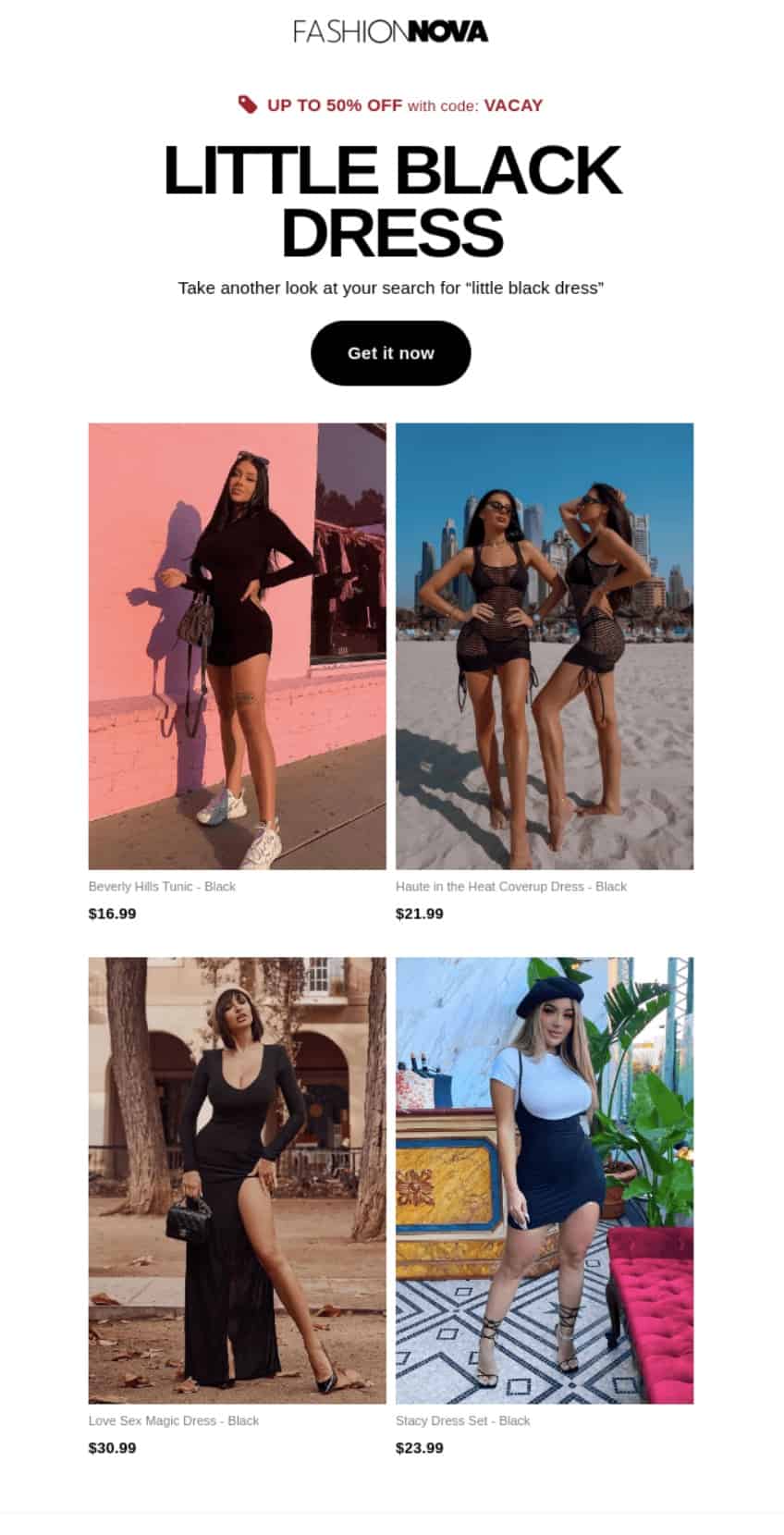
Upselling is simply the process of getting customers to buy something more than they have already purchased. For example, if a customer is interested in buying a black dress, you can upsell other black dresses at a slightly higher price range.
You can also include other colors of the same tone. The goal is to get your customer to widen the scope of the products they were considering buying.
Here are some expert tips for your next upsell email:
- The timing of your upsell email matters a lot. Otherwise, you just seem very pushy. You can send out upsell emails for cart abandonment, browsing abandonment, at the end of a subscription period or trial period, for customer milestones, and immediately after their purchase.
- Upsell only those products that are relevant to the customer. For instance, if someone has searched for ‘little black dress’, sending them recommendations for brightly colored dresses may not work. Instead, you can upsell other black dresses or an overcoat.
- Ensure that the email campaign is personalized and automated.
Read also: How AI Is Revolutionizing ECommerce Email Marketing
10. Shopping cart abandonment emails
Subject Line: Hey {customer name}, your planner is waiting!

Shopping cart abandonment emails are very crucial for eCommerce stores. The goal of this email is to remind the prospect about items in their cart and to entice them to complete the purchase.
Here are some expert tips for cart abandonment emails:
- Automating this follow-up email is sure to save you time and effort.
- Keep the email free of distractions by providing only one call to action (CTA) button. A catchy, personalized subject line can help with open rates.
- Clearly specify the items in the cart for easy reference.
- You can also consider including an offer or a discount to entice prospects. The top reason for cart abandonment is high add-on costs, so including a free shipping offer at this stage can lead to more conversions.
👉Boost your ecommerce success with the ultimate marketing automation strategies – dive into our in-depth guide today! 🚀
Read also: Winning In A Competitive World: ECommerce Marketing 101
11. Survey emails
Subject Line: Help us shape the future of eCommerce

Another kind of follow-up email that most eCommerce companies have to master is feedback or survey emails. This is a valuable source of info for your marketing strategies. So, the goal of this email is to get as many responses as possible.
Here are some expert tips for feedback or survey emails:
- Send personalized emails to highlight the customer’s value to your company. Make them feel valued before proceeding to request feedback.
- You can include a clear call to action button to help customers begin the survey. Be clear about how their feedback will help your company.
- One option is to include a net promoting score (NPS) survey. This means the customers will have to rate the experience on a numerical scale from 1-10 or 1-5.
- Inform the customers about the time it would take to complete the survey. Ideally, keep it to below five minutes. Nobody likes long-winded surveys.
- Offer incentives or a thank-you gift for completing the survey. This way, customers too get value as they help you out.
Read more: CRM in eCommerce — The Perfect Partners for Personalization
12. Thank-you emails
Subject Line: Thank you for your purchase!
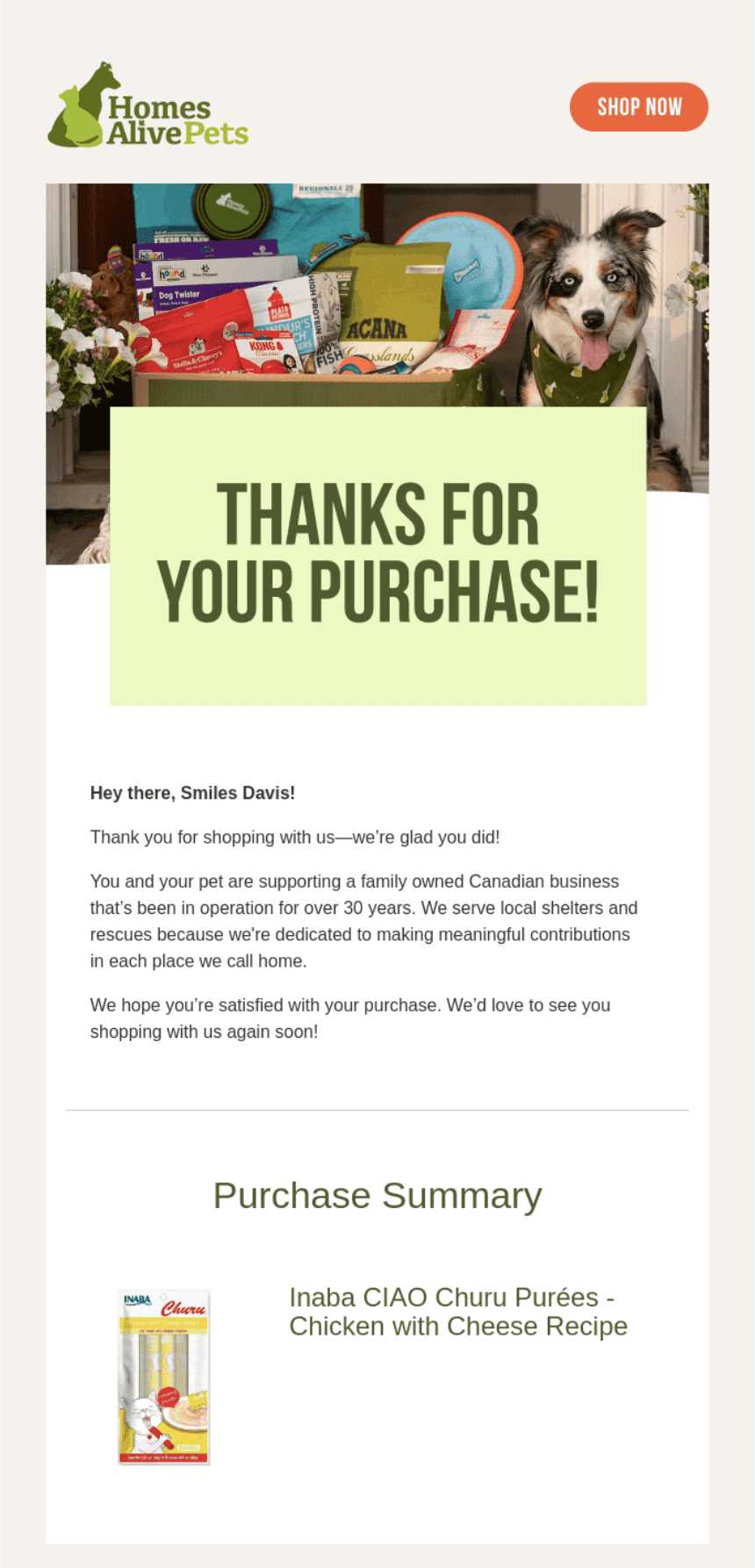
In today’s world, thank-you emails have become absolutely crucial. This not only makes the customer feel valued but also builds a relationship with the customer. Repeat customers are the cornerstone of business in any industry.
And happy customers are more likely to recommend your products to their friends and family.
Here are some important tips for thank-you emails:
- Confirmation and thank you emails are opened 70% more than the average promotional email. So, use this opportunity to build a rapport and establish your brand in the minds of the customers. Get creative with this email.
- You can also send thank you emails to customers for subscribing to your newsletter, getting a premium membership, or just as a check-in during the holiday season.
- Remind customers of the value they have gained by supporting your brand. Also, include a summary of their order.
- For high-value repeat customers, you can use this opportunity to cross-sell related products before shipping.
Read also: Email Anatomy 101: Essential Email Parts You Shouldn’t Ignore
13. Win-back emails
Subject Line: Come back and get a 20% off perk
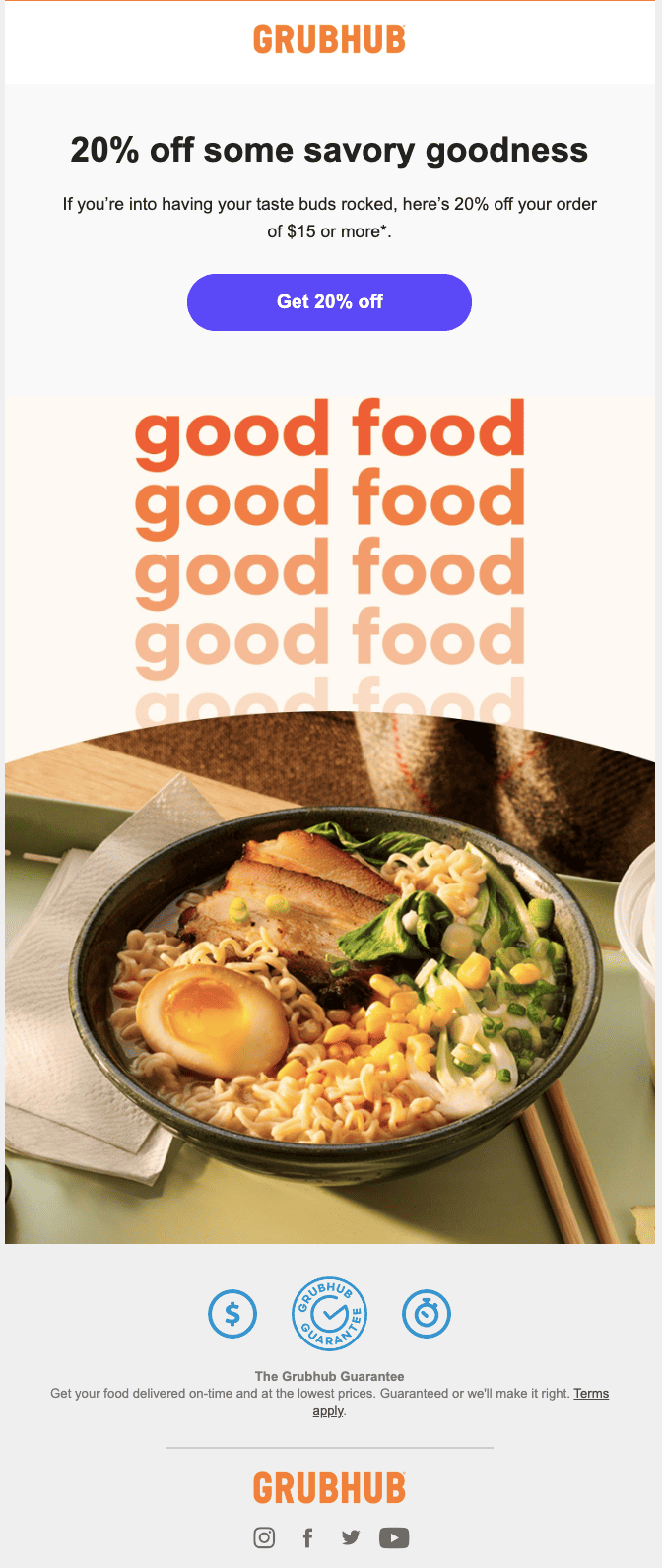
The goal of these emails is to target customers who have been inactive for a while and entice them to come back and make a purchase from your eCommerce store. Of course, discounts don’t work all the time.
So, here are some tips to help you craft a successful win-back email for more conversions:
- First, segment your contact list based on their last activity with your website. Define what a lapsed contact means for you. You can set up separate automated email campaigns based on the number of days the prospect has been inactive. A series of 3-4 emails are usually successful in getting the maximum conversion rates.
- The email should reach the right customer at the right time.
- Include a clear call to action button that clearly highlights the value they will gain by purchasing at this time.

Read also: 15 Email Marketing Examples to Inspire Your Next Campaign
14. Referral emails
Subject Line: 50% off for you and your friend!
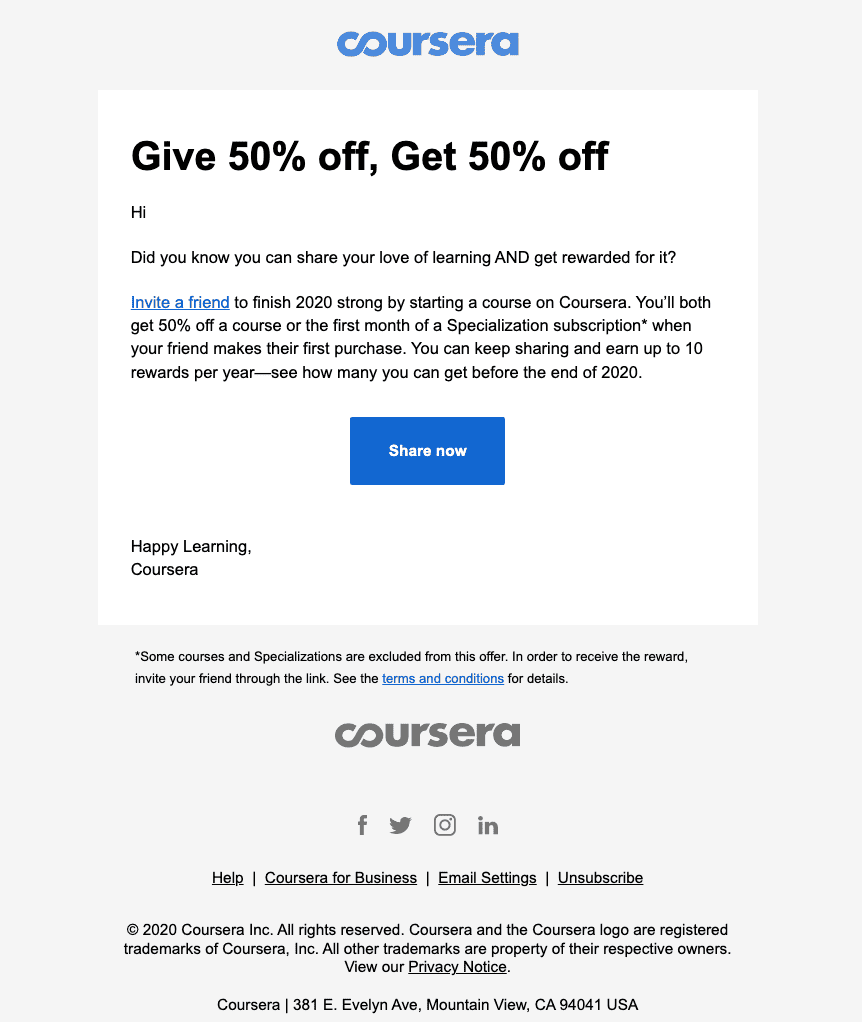
Referrals are an important way for your eCommerce store to get new leads. It also helps establish your brand as a trustworthy one. A Nielson survey found that prospects are four times more likely to buy a product if a trusted friend or family member recommends it.
Here are some tips to get you started:
- Try to include a referral deal or bonus as a gift. The goal is to create a win-win situation for the customer and the friend.
- Have a clear call to action button. Avoid multiple CTA buttons, as this will be distracting.
- Clearly lay out the value that customers and their friends can expect to get with the referral program.
- Keep the body of the email and the graphics simple, yet compelling.
- Enable share buttons so that prospects can share your deal with their friends through different channels like WhatsApp, social media, or emails.
15. Curation emails
Subject Line: Gel, Styling Serum, or Curling Custard? Choose yours today! 😎
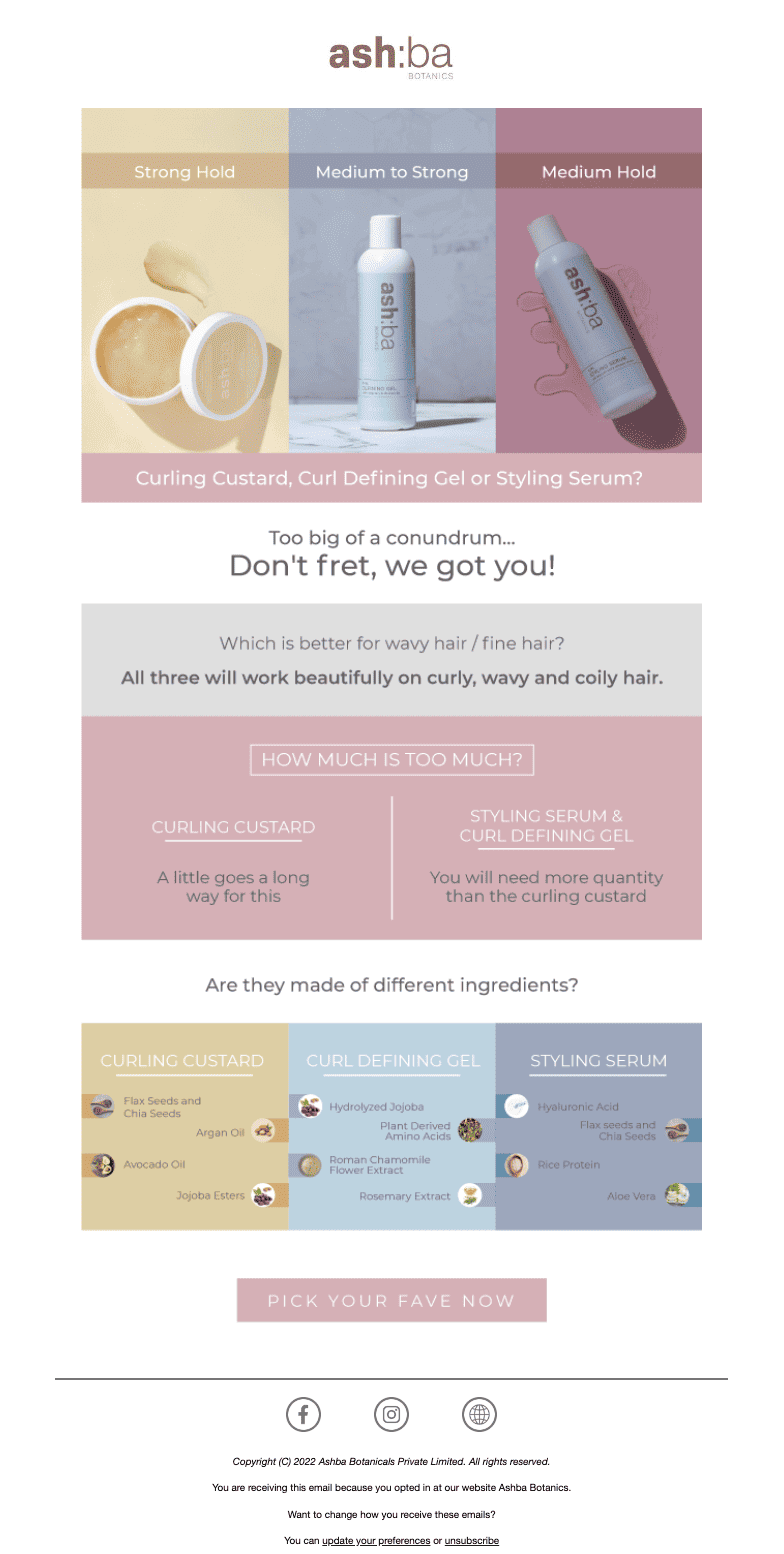
Curation emails are simply emails that you send with curated, premium content for your eCommerce store. This could range from sharing top blog posts each month to sharing curated seasonal products for your customers.
These emails will help keep your products in the minds of customers. It is also a great way to build credibility and offer expert tips to customers.
Some important points for curation emails:
- Decide on a time frame for sending curation emails. Too many curation emails will stale the relationship.
- This is a great way to show off your expert knowledge. In the example above, there are tips on the product that’s suitable for different hair types and the quantity to be used. All the different ingredients are laid out clearly. So, put your expert knowledge to work and educate your customers on products that are best suited for them.
- Ensure that curation emails are visually appealing to look at. Include high-resolution images and engaging graphics.
- An easy hack to re-purpose existing content and top-performing blogs to include in your curation email.
Read more: eCommerce Content Marketing and Why You Need It
Top Tips for a Successful eCommerce Email Campaign
Now that you’ve got a good sense of the different types of emails and email campaigns, let’s drill down the best practices for your eCommerce email marketing campaigns.
1. Automate emails at key touchpoints
Automating your email campaigns for each touch point will help you save time and send personalized emails to the right customer at the right time. And, all this happens without you having to put in any manual effort once the automation is set up.
Now, touchpoints are simply a point of interaction between your company and the customer. Touchpoints are usually recorded on a customer journey map. Touchpoints include everything from when your customer clicks on one of your ads, to browsing on your site, adding to cart, etc.
This helps you create a smoother customer experience, with minimal effort from your end.
Read more: eCommerce Integration — Do You Need It?
2. Choose the right email frequency
This is extremely important. Too many emails sent to too many prospects can get your bounce rate going high.
On the other hand, infrequent emails can cause you to miss out on excellent conversion opportunities. So, the key is to strike the perfect balance for your company based on the number of subscribers you have.
As a rule of thumb, eCommerce companies should send an average of 10-19 emails a month. However, the number could be higher or lower depending on how many subscribers you have.
3. Segment your list
Segmenting your email list is a crucial step if you want to see actual results. You can segment your email list to send targeted and personalized email campaigns.
Here are some factors to consider while segmenting your email list:
- Demographic segmentation based on age, gender, location, etc.
- Segmenting based on the customer position in the sales funnel
- Previous engagement-based customer segmentation
- Period of inactivity
4. Use a dedicated service
Choosing the right email marketing software based on your unique needs will take you a long way.
Some factors to keep in mind while choosing the perfect email marketing software for your firm:
- Determine the features that are non-negotiable for you. For instance, eCommerce companies will need to set up a lot of automated email campaigns. Make a list of all the essential features and another list of features that are optional but preferred.
- Look for eCommerce-specific features.
- Do some comprehensive research on different email marketing software, their features, and their pricing plans.
- Choose the most suitable option based on your needs and marketing budget.
Read more: 13 Best Email Marketing Software to Grow your Business
5. Create a sense of urgency, but don’t overdo it
FOMO marketing usually works pretty well. But, don’t overdo it. The goal is to entice customers to make a purchase, but too much of it can erode trust in your company. Not only that, it can cause many people to unsubscribe from your list.
So, remember to strike the right balance.
6. Always A/B Test your eCommerce emails
A/B Testing or split testing is a great way to optimize your eCommerce emails for maximum reach.
Here are some factors you can A/B test:
- Different subject lines for the same campaign
- Optimal time of delivery of the emails
- Writing style, tone, and formatting of the email body
- Elements of design and layout
- Different call-to-action (CTA) buttons
- Length of content
This eliminates guesswork about each factor listed above. This will help you streamline future email campaigns as well.
Read more: 11 Tested Tips to Improve Open Rates Through Email A/B Testing
Wrapping Up
Email marketing is the cornerstone of any eCommerce marketing strategy, and for good reason.
Andrea Mingolo makes a great point about this:
“I want to do business with a company that treats emailing me as a privilege, not a transaction”.
After all, isn’t that how we’d all like to feel?
Let us know which tips resonated with you the most in the comments below 🙂
Also, if you think an email marketing automation tool that comes with CRM and customer support features can help your business, try EngageBay. More than 46,500 business owners love it already!
